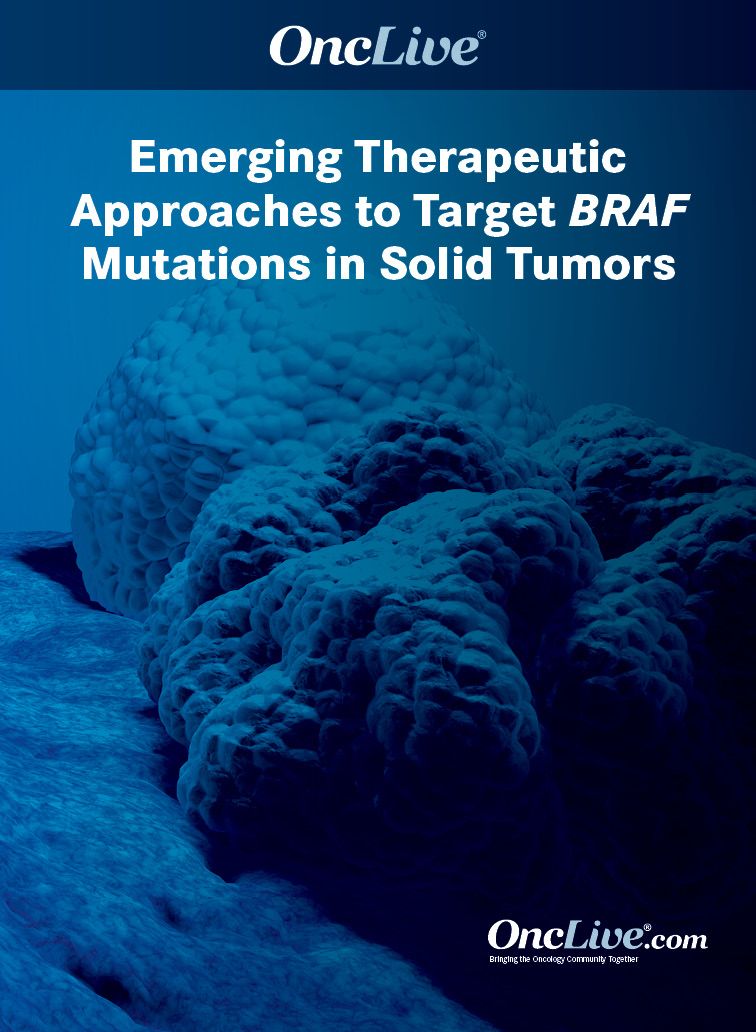Publication
Article
Supplements and Featured Publications
Investigation Into the Actionability of Atypical BRAF Mutations Continues in Solid Tumors
Author(s):
Developing BRAF inhibitors for patients with atypical class II and III mutations has become an exciting area of research.
Shumei Kato, MD

Developing BRAF inhibitors for patients with atypical class II and III mutations has become an exciting area of research, explained Shumei Kato, MD, who added that although pan-RAF and ERK inhibitors are currently under study as single agents in this population, investigation into co-alterations for potential combination approaches is already under way.
“Both [class II and III BRAF mutations] seem to be ideal targets, especially in targeting RAF itself or downstream [signals] like MEK and ERK,” Kato said. “There are a lot of clinical trials that have been focusing on these atypical forms of BRAF mutations. It is an exciting time.”
“I’m hoping we will see some good outcomes even with single-agent approaches, but if [that is not successful], perhaps the next step will be to consider some flexible combination approach. We will see how that goes,” Kato added.
In an interview with OncLive®, Kato, a medical oncologist and assistant professor of medicine in the Department of Medicine at the University of California San Diego (UCSD) Health, discussed the rationale to target class II and III BRAF mutations in solid tumors, the benefit of next-generation sequencing (NGS) testing, and ongoing clinical trials gathering data on this research.
OncLive®: Why should class II and III BRAF mutations be evaluated for potential actionability in oncology?
Kato: [With] larger panels, like NGS, we are identifying more genes that are theoretically actionable, such as atypical BRAF mutations. [Atypical non–BRAF V600E mutations are found in a small percentage of] cancer types. There is a lot of interest when it comes to targeting those mutations.
BRAF mutations are classified into 3 different classes. Class I [mutations] are more typical like V600E mutations. Initially, [these mutations were] targeted among patients with melanoma, but now we are seeing more applications in different histologies like lung cancer, colon cancer, or other rare tumor types like Erdheim-Chester disease. Now, [class I mutations] are more targetable with a typical BRAF or MEK inhibitor, although for colon cancer, we need to add an EGFR inhibitor.
The more we use NGS, [the more] we are identifying the atypical class II and III BRAF mutations. Class II BRAF mutations can lead to increased dimerization of BRAF, which can lead to downstream MEK/ERK [signaling] and progressive cancer. Class III mutations are inactivated, so theoretically, they are not going to be ideal targets. However, interestingly, when BRAF is inactivated, c-RAF will be recruited, which can ultimately lead to the downstream signaling activation of MEK and ERK.
You published a paper in Nature Communications regarding the real-world benefit of molecular tumor boards in matching patients with alterations to specific targeted therapies. Could you provide some insight into the purpose of the paper and what the results demonstrated?
Thank you for asking about our molecular tumor board experience at UCSD. Razelle Kurzrock, MD, of UCSD Moores Cancer Center, initially developed the molecular tumor board at UCSD. The initial idea was to try to guide the physician who may not be familiar with complex molecular pathways. That has evolved with more evidence when it comes to matched targeted therapy approaches. However, we also noticed with our experience that single-agent approaches may not be enough for the patient. We know that when we do molecular profiling on solid tumors, patients on average will come in with 3 or 4 alterations [identified] by a large NGS panel. However, most of our clinical trials are focusing on [targeting] 1 gene at a time. That could, of course, work, as we have seen with EGFR mutations in lung cancer and BRAF mutations in melanoma. We also know though that single-agent targeted approaches have some limitations with early progression.
Therefore, we created a protocol where we could capture the data if we were to treat the patient with a combination approach based on the patient’s unique molecular profile.
In short, what we have found is that if we can target more alterations with different drugs or combinations of drugs based on each patient’s molecular profiling, patients may do better. For example, let’s say a patient comes in with gene A, B, or C. If we can correlate those genes with drug A, B, or C, we believe patients will have better clinical outcomes. That is what we have seen from our molecular tumor board experience.
Do you anticipate that experience can be extrapolated to the patient population harboring atypical BRAF mutations as well?
In the atypical BRAF-mutated population, [we are evaluating] single-agent approaches with pan-RAF inhibitors or ERK inhibitors. However, those patients most likely will have other co-alterations that could be co-targeted. We will see how the results go with single-agent approaches. If that is sufficient, that will be great, but if we are seeing similar mutations as we see in [patients who receive] other single-agent targeted therapy approaches, perhaps the next step will be to combine medications based on the patient’s molecular profiling.
There is a lot of difficulty [in doing that] though because it is more complex than we think. Let’s say we have 100 patients with colon cancer. If we do the large panel of NGS, even though they come in with similar histologies or microscopic findings, every patient will have different alteration patterns. They may have common mutations from patient to patient, but when it comes to the big picture, they are all different, like malignant snowflakes. That means we may have to come up with some customized approach based on each patient’s molecular profiling. That will be the next [phase of research].
What research is ongoing in this space with pan-RAF inhibitors and ERK inhibitors?
We do have FDA-approved medications with different MEK inhibitors, especially for melanoma. However, there are more potent RAF inhibitors or even [medications] targeting downstream ERK [in development]. It is worth trying [to develop these] for patients.
How do these agents distinguish themselves from traditional BRAF inhibitors? Given the differences in their mechanism of action, are there anticipated differences in toxicities?
There are a couple questions: What is the difference between typical BRAF inhibitors in terms of toxicity. I don’t know in depth; however, for typical BRAF V600E inhibitors like vemurafenib [Zelboraf], [the agent] is only targeting that specific mutation. So, it won’t work for different mutations [like atypical BRAF mutations]. [KIN-2787], which is under investigation in an ongoing clinical trial, [may] inhibit different BRAF mutations.
Additionally, regarding ERK inhibitors, we don’t have a lot of clinical data, though there are promising preclinical data using ERK inhibitors for patients with typical BRAF mutations. The clinical side has still not matured, so it is worth investigating.
When it comes to the toxicity profiles, I will assume it will be very similar to the BRAF or MEK inhibitors we already have. [Toxicities will likely include] rash, diarrhea, and so on. Those will be the common toxicities, but we will have more data in the future.
Are these atypical BRAF mutations being automatically tested for on broad NGS panels or do clinicians have to specifically ask for those alterations to be tested?
My understanding is that most main NGS [panels] will automatically catch those mutations. The major laboratories will [identify] them and if it is not reported, the patient is [deemed] negative.
Is there any inclination yet as to the likelihood of co-mutations presenting in patients with atypical BRAF mutations, or is it too early to tell?
There are a lot of publicly accessible data. Also, at UCSD, we have our internal data. I haven’t had a chance to investigate atypical BRAF mutations, specifically. However, for example, we have investigated patients with RAS mutations, which is upstream of BRAF. These are publicly accessible data. We found that 90% of patients will have some kind of co-alteration alone with RAS mutations. The most common [co-alterations] were PI3K pathway alterations, cell cycle alterations, and TP53 mutations. Also, about 20% of RAS-mutated patients had interesting co-alterations in other TKI pathways. I assume that even for the atypical BRAF-mutated patients, they will have different types of co-alterations very frequently.
Are there active clinical trials at UCSD you’d like to highlight in this realm?
[At UCSD], we have 2 active trials looking at [agents for] atypical BRAF mutations. One is a pan-RAF inhibitor, and the other is an ERK inhibitor. We are trying to open a couple more similar but different [studies] looking at different populations. There is a high interest in this patient population.










